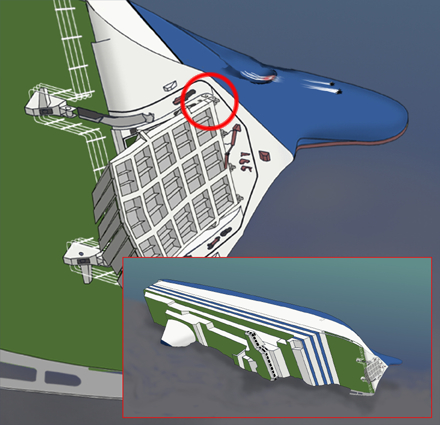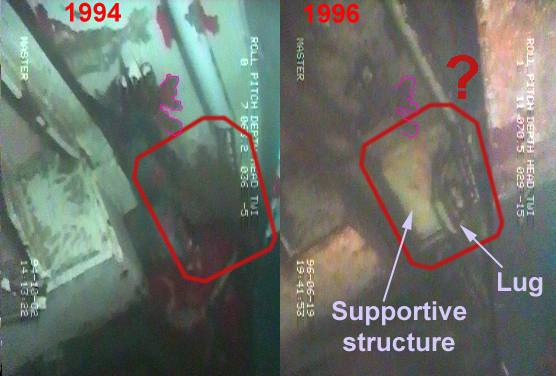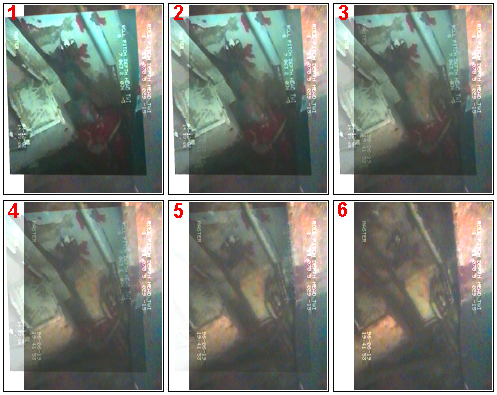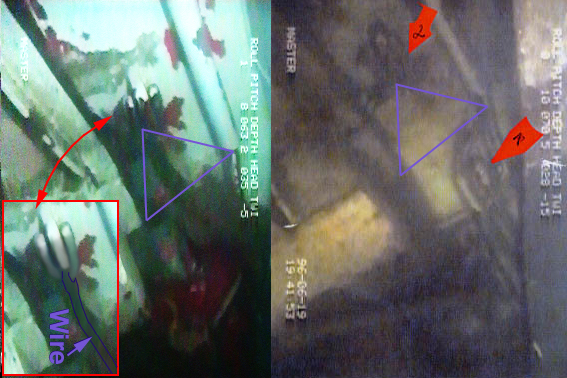© 2006 The Independent Fact Group
![]()
![]()
© 2006
The Independent Fact Group
| Subject: | Analysis of the forward bulkhead 1994 versus 1996 |
| Type: | Analysis |
| By: | The Independent Fact Group |
| Status: | Proved |
| Date: | 2006-04-04 |
| Version: | Report-English |
The Fact Group's aims and objectives:
The Independent Fact Group was formed in early 1999 to clear up the many question marks about the M/V Estonia disaster, in a structured and methodical manner. There has been considerable speculation concerning the efforts of the Joint Accident Investigation Commission (JAIC) and the political, legal and media treatment of the accident and its tragic consequences.
The aim is to give those in authority an opportunity, based on the facts of the case, to decide to review this matter, with a view to further action. Our efforts also enable the media and the general public to decide on the basis of the objective information which is available concerning the accident, and the conclusions to be drawn from a technical and civic perspective.
The overall objective is the setting up of a new investigation of the accident which can describe the course of the accident in detail, and its causes, with subsequent assessment of the moral and legal responsibilities, where this is feasible.
We are motivated by the belief that a properly conducted investigation will contribute to maritime safety and by our concern for Sweden's reputation as a nation which upholds safety at sea and the rule of law.
Methodology:
In the course of this task, we have assumed that the solution of a problem is never better than the validity of the basic assumptions. As a result, we have stipulated some methodological principles, of which the following are the most fundamental:
1. All scenarios must be considered to be true until the contrary
is proved.
2. All observations, assumptions or statements on which a scenario
is based must be considered false until the contrary is proved.
We have defined a number of criteria for concluding that an observation, assumption or statement may be considered to be true or false, and processes and routines for the route to be taken in clarifying an observation, assumption or statement. These criteria involve technical, empirical, statistical and/or semantic requirements which, if they are relevant must all be met if the observation, assumption or statement is to be classified as an objective fact.
The materials we have worked with are primarily the documents, audio recordings and films in the Swedish Accident Investigation Commission's Estonia archive, together with supplementary information from other public sources and, in addition documentation from the Meyer shipyard and its independent commission.
Activities at M/V Estonia between 1994 and 1996.
Summary
In this report the Independent Fact Group shows that the video films taken by JAIC in 1994 and 1996 (oil recovering) on the wreck of M/V Estonia, reveals, among other things, that extensive activities have been performed on the wreck after December 1994 and before the summer of 1996.
Se also earlier report of similar activities "Analysis of the ramp 1996 versus 2000".
The activities must have involved underwater welding close to the ramp at the forward bulkhead just beside of the port bottom corner of the ramp. A large lug has been attached to the bulkhead, and on the videos from 1996 there seem to be a wire attached to the lug. The circumstances was first reported by the German Group of Experts (GGE) who found the divergence when comparing videos taken in 1994 with those taken in 1996. However the GGE did not come to the conclusion that the lug had been attached to the ship after the accident, but found that the lug was attached to the ship by the shipyard and that it was not visible because it was covered by some "sealing material [a rug or mattress]" that was in the area and prevented the lug to bee seen in the video from 1994.
Our analysis will show that the GGE conclusion was partly wrong and that the lug must have been attached to the ship in the period 1994 - 1996.
The evidence can clearly be seen when comparing the earlier video material recorded by the JAIC in 1994 with the videos recorded during the recovery of oil during 1996.
Definitions of certain language marks used in this report:
Text presented from the German Group of Experts report (site) is quoted as printed.
Background
The following picture show the area subject to this analysis report, marked with a red circle.

The German Group of Experts
The following three pictures 1, 2 (text) and 3 are from the German Group of Experts site http//:www.estonia.xprimo.de/ and show a part of their comparison between videos taken 1994 and 1996.
Picture 1. This video picture is from 94.10.02 at 14:13. The drawing to the right show from where the video print was taken on the forward bulkhead (in yellow).

Picture 2. Text related to Picture 1 and 3. The GGE states that "According to the yard the wire steering of the upper bow ramp flaps had been fastened to this lug (arrow 1)." and further that "Arrow 2 points to some damage in the bulkhead which was previously also not visible due to "sealing material"."
The Independent Fact Group will show that "Arrow 1" that according to GGE points out a lug that was not seen in 1994 due to the presence of "sealing material" in fact was not even attached to the bulkhead at that time. We will also show that "Arrow 2" does not in fact point out damage but the true lug for the wire steering of the upper bow ramp flaps.
Picture 3. This video picture is from 96.06.19 at 19:41. It is also a further detailed picture made by GGE with drawings to clarify what they believe can be seen on the video-picture.
No one of the video films taken during the JAIC investigation of the wreck during 1994 show any trace of the lug that later can be seen on the video from 1996.
Analysis of the videos 1994 and 1996
The most obvious divergence is that in the video from 1994 the area in question for this report seems to show severe damage not seen in the later video from 1996. It can be seen as a supportive structure where a rather large lug is attached, and the supportive structure clearly painted white.

Picture 4a and 4b. The picture to the left shows a comparison of the area within the red marking without and with the lug. Picture 4b show in detail the outline of the lug.
In the picture from 1996 we can clearly see that not only a lug has been attached but also some sort of supportive structure, a box like construction has been welded to the bulkhead.
To further check the correspondence between the pictures from 1994 and 1996 we have transformed the pictures on top of each other after correction in scaling and perspective (made on the 1994 picture). The transformation is shown in the following picture 5 from 1994 to 1996 where the transparency is changed 20 % between each picture.

Picture 5. Part 1 show the picture from 1994 non transparent, and part 6 show the picture from 1996 non transparent.
The pictures indicate without doubt that there has been a dramatic change from 1994 where a lug has been adapted.

Picture 6. In this picture the damage referred to as "some damage" (2) in the GGE report pointed out with arrow 2, is shown to be the true lug and shackle for the wire steering of the upper bow ramp flaps. The fact is that there was no other lug attached to the bulkhead by the shipyard than the lug for the wire steering.
It leaves us with further indications of extensive underwater activities on the wreck, performed by unknown parties for unknown reasons but also during a time with constant guardian and protection from both the Swedish and Finnish authorities to protect the ship from any such activities.
The Fact Group conclusion
These findings are further evidence for hidden activities at the MV Estonia shipwreck, all against every official statement and all in spite of the laws for protection of the shipwreck. It is further most unlikely that these activities can have taken place without knowledge by the Swedish and Finnish authorities that guard the shipwreck with every possible effort.
Questions
Who has been working down there and why?
Have these activities anything to do with the damage later caused to the ramp and shown in earlier IFG report?
DEDICATION
We dedicate this report to all those who lost their lives at sea as a result of a ships lack of seaworthiness.
If MV Estonia had been seaworthy many of the more than 850 persons who lost their lives would have had a chance to survive.
Troon, Scotland 4 April 2006